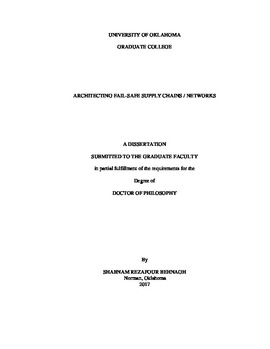| dc.contributor.advisor | Allen, Janet K. | |
| dc.contributor.advisor | Mistree, Farrokh | |
| dc.contributor.author | Rezapour Behnagh, Shabnam | |
| dc.date.accessioned | 2017-05-12T13:15:51Z | |
| dc.date.available | 2017-05-12T13:15:51Z | |
| dc.date.issued | 2017-05-12 | |
| dc.identifier.uri | https://hdl.handle.net/11244/50803 | |
| dc.description.abstract | Disruptions are large-scale stochastic events that rarely happen but have a major effect on supply networks’ topology. Some examples include: air traffic being suspended due to weather or terrorism, labor unions strike, sanctions imposed or lifted, company mergers, etc. Variations are small-scale stochastic events that frequently happen but only have a trivial effect on the efficiency of flow planning in supply networks. Some examples include: fluctuations in market demands (e.g. demand is always stochastic in competitive markets) and performance of production facilities (e.g. there is not any perfect production system in reality).
A fail-safe supply network is one that mitigates the impact of variations and disruptions and provides an acceptable level of service. This is achieved by keeping connectivity in its topology against disruptions (structurally fail-safe) and coordinating the flow through the facilities against variations (operationally fail-safe). In this talk, I will show that to have a structurally fail-safe supply network, its topology should be robust against disruptions by positioning mitigation strategies and be resilient in executing these strategies. Considering “Flexibility” as a risk mitigation strategy, I answer the question “What are the best flexibility levels and flexibility speeds for facilities in structurally fail-safe supply networks?” Also, I will show that to have an operationally fail-safe supply network, its flow dynamics should be reliable against demand- and supply-side variations. In the presence of these variations, I answer the question “What is the most profitable flow dynamics throughout a supply network that is reliable against variations?” The method is verified using data from an engine maker. Findings include: i) there is a tradeoff between robustness and resilience in profit-based supply networks; ii) this tradeoff is more stable in larger supply networks with higher product supply quantities; and iii) supply networks with higher reliability in their flow planning require more flexibilities to be robust. Finally, I will touch upon possible extensions of the work into non-profit relief networks for disaster management. | en_US |
| dc.language | en | en_US |
| dc.subject | Supply chain | en_US |
| dc.subject | risk management | en_US |
| dc.subject | disruptions | en_US |
| dc.subject | resilience | en_US |
| dc.title | Architecting Fail-Safe Supply Chains / Networks | en_US |
| dc.contributor.committeeMember | Trafalis, Theodore | |
| dc.contributor.committeeMember | Karabuk, Suleyman | |
| dc.contributor.committeeMember | Lakshmivarahan, S | |
| dc.date.manuscript | 2017-05-12 | |
| dc.thesis.degree | Ph.D. | en_US |
| ou.group | College of Engineering::School of Industrial and Systems Engineering | en_US |
| shareok.nativefileaccess | restricted | en_US |
